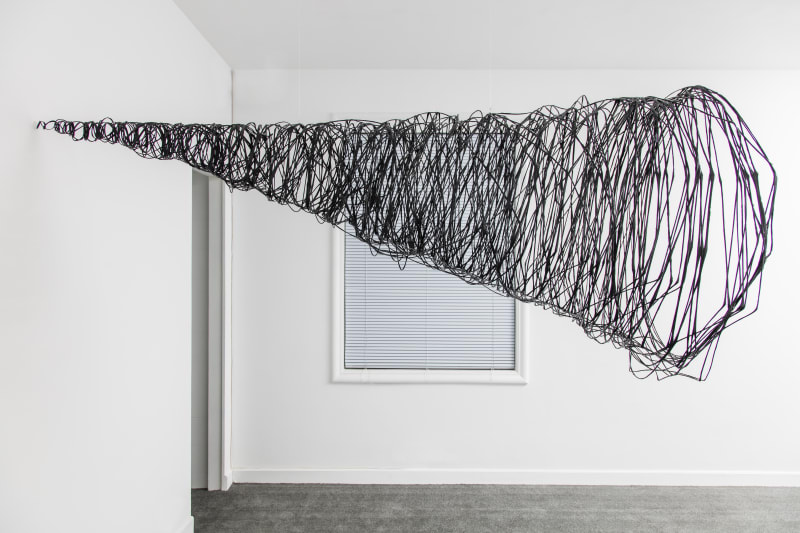The core of Feng Chen's solo show at Capsule Shanghai is a group of video installations that each stands alone, but also correlates to one another. Placed in different rooms within the gallery, each work seems to be independent, together they maintain a perfect synchronization. This group of works is originated from Feng Chen's reflection on the relationship between sound and image. One central view on such a relationship – let’s call it “naturalism” for the sake of simplicity – suggests that since the world is harmonious, the relationship between sound and image is naturally harmonious; yet both sound and image become distorted or incomplete in their representations through various mediums, thus embodying “the sin of technology”. Another view sees the world itself as a form of representation. There is no stable relationship inherent to sound and image; human beings can only speculate about and simulate the world through cognition. It is quite evident through the exhibition that Feng Cheng is more interested in the latter view.
If video is more than a form of recording, then creating a video piece goes beyond shooting and editing materials, but creates more importantly a mechanism to produce a relationship between sound and image. Let’s take Feng’s The Darker Side of Light, a site-specific work for the solo show as an example. Its creation is in fact also about establishing rules – with the help of the rules, the synchronization of the visual and auditory senses in a video is dissected and then reconnected in the artwork. Using sounds to change the focus of the lens, the artist first shot images, then dubbed them with new sounds; as the final step, he used these new sounds to drive the blinds in the room to flap, again making new sounds and causing light changes.
Sound controls movement, movement creates images, and images trigger other sounds. In the looping of “movement – sound – movement – image – movement – sound – movement – image”, information constantly undergoes transformation through various time, space and mediums, finally represents itself as a seemingly unremarkable short audio-visual sequence. The same piece of work is shown on several screens placed in different spots in the gallery while one screen plays multiple pieces on loop. Viewer wandering around the gallery and wearing a wireless headset would hear specific sounds depending on where they are. It is almost impossible for them to tell which parts of their experiences have been altered and how each part relates to the others. The involuntary mechanical quivering of human skin and muscles in Convulsion, the ever-changing focus of the camera in Untitled and the noises resounding in the rooms of the gallery – together they form another world. As the blinds flash open, light from outside enters, merging the imagined and designed virtual world as created by a manifold of transformation and translation of data, with the real world as experienced by the viewers. We can’t help but wonder, which one constitutes reality?
A similar question was proposed more directly in the work 7 Real Magic Books – The Second Hypnosis: can images truthfully document reality? Currently, reality, as captured by images, has become so unstable that as soon as perspectives change, new images appear and bring about new realities. If we further pursue this train of thought, would it be conceivable that reality could host endless possibilities since there seems to be an endless array of perspectives? In fact, seeing itself is no more than our interpretation of external signals. It is our brain that combines the all those bits of information transmitted by optic nerves to form a meaning. People born with cataracts are not able to perform such a task. Even after an operation removing their disabling physical condition, they still can’t put incoming visual information into a meaningful image, therefore, they only see lights in disarray. We hypnotize ourselves into believing that we can objectively observe and describe the world, into believing that what we see is real. The artist, however, makes use of this false belief to hypnotize us for a second time.
Consequently, the existence of all things should be deemed as indefinite as long as they are not observed. The human perception serves as a kind of “measurement”, making them collapse into some definite state. Expression, perception and reality bond to and interact with each other in labyrinthine ways. We live these days among varied graphic and audio interfaces and have gotten used to modified experiences, but Feng Chen’s work reminds us to be aware of the power of medium in operation. Perhaps we even need to redefine how we stand with reality. According to what Donald Hoffmann calls as “conscious realism”, what matters is not what the perceived world really is, but how we feel and react to what we have perceived. In other words, all our perceptions of reality are,in the end, “illusions”. There is no independent reality beyond our experience. Therefore, experience is the most essential and authentic part of existence and the ultimate nature of reality.
© ARTFORUM.COM.CN
Bruce Ding's Text, translated from the Chinese by Ken Zhao & Zoey Wan and proofread by Eva Zhao, was originally published on Artforum website and Wechat account.



